Financial Analysis: EOQ, Investment Appraisal, Ratios & Governance
VerifiedAdded on 2023/06/17
|15
|4054
|364
Report
AI Summary
This report provides a comprehensive analysis of various financial techniques, including Economic Order Quantity (EOQ) for inventory management, investment appraisal methods such as payback period and Accounting Rate of Return (ARR), and financial ratio analysis for performance evaluation. It critically evaluates the EOQ model and Just-In-Time (JIT) approach for inventory management, offering recommendations for their implementation. The report also advises on investment decisions, comparing options using payback period and ARR, and discusses the advantages and disadvantages of different investment appraisal techniques. Furthermore, it explores the role of organizations in the international regulatory framework for accounting and the role of the audit committee in corporate governance. This analysis aims to provide a thorough understanding of financial management principles and their practical applications.
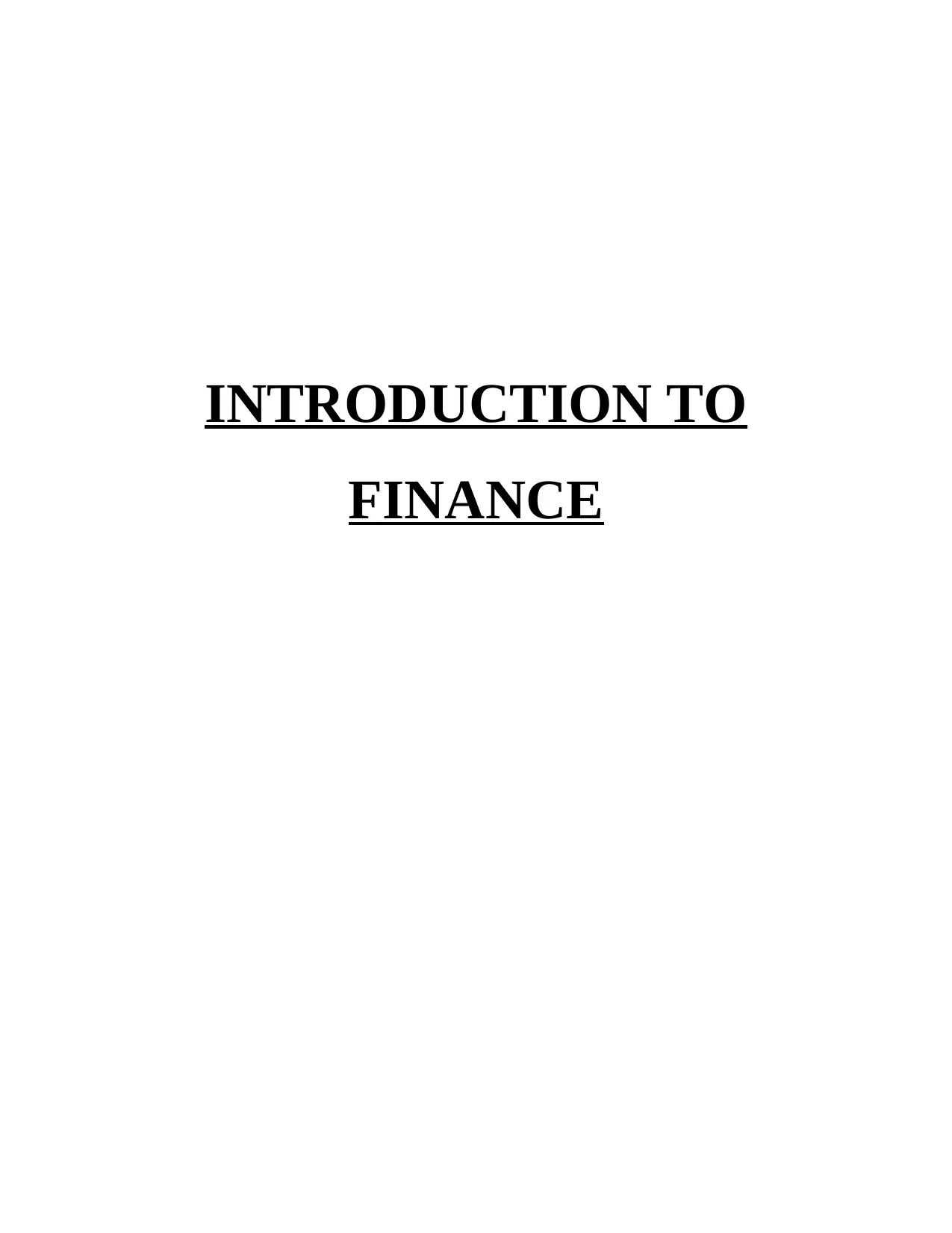
INTRODUCTION TO
FINANCE
FINANCE
Paraphrase This Document
Need a fresh take? Get an instant paraphrase of this document with our AI Paraphraser
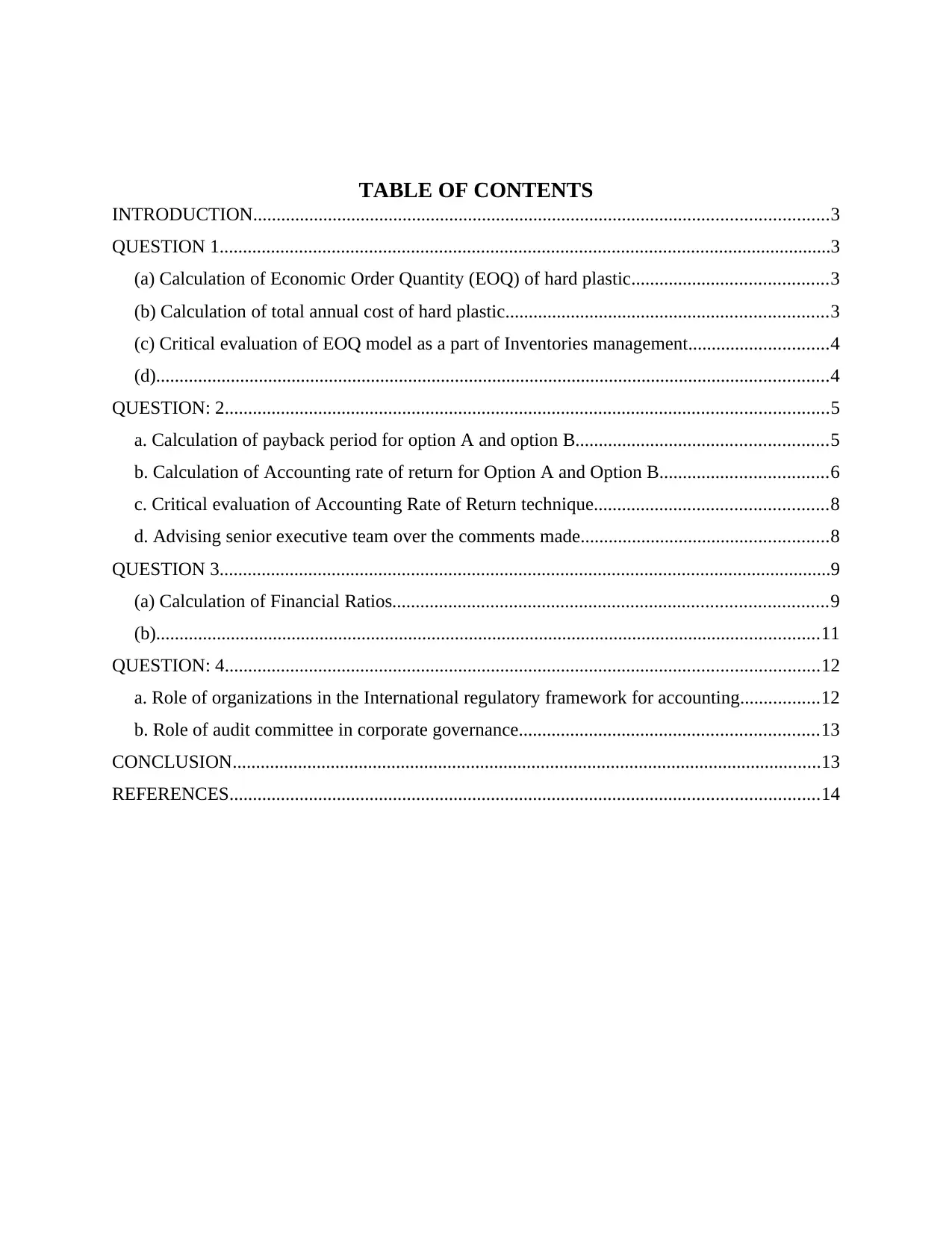
TABLE OF CONTENTS
INTRODUCTION...........................................................................................................................3
QUESTION 1...................................................................................................................................3
(a) Calculation of Economic Order Quantity (EOQ) of hard plastic..........................................3
(b) Calculation of total annual cost of hard plastic.....................................................................3
(c) Critical evaluation of EOQ model as a part of Inventories management..............................4
(d)................................................................................................................................................4
QUESTION: 2.................................................................................................................................5
a. Calculation of payback period for option A and option B......................................................5
b. Calculation of Accounting rate of return for Option A and Option B....................................6
c. Critical evaluation of Accounting Rate of Return technique..................................................8
d. Advising senior executive team over the comments made.....................................................8
QUESTION 3...................................................................................................................................9
(a) Calculation of Financial Ratios.............................................................................................9
(b)..............................................................................................................................................11
QUESTION: 4...............................................................................................................................12
a. Role of organizations in the International regulatory framework for accounting.................12
b. Role of audit committee in corporate governance................................................................13
CONCLUSION..............................................................................................................................13
REFERENCES..............................................................................................................................14
INTRODUCTION...........................................................................................................................3
QUESTION 1...................................................................................................................................3
(a) Calculation of Economic Order Quantity (EOQ) of hard plastic..........................................3
(b) Calculation of total annual cost of hard plastic.....................................................................3
(c) Critical evaluation of EOQ model as a part of Inventories management..............................4
(d)................................................................................................................................................4
QUESTION: 2.................................................................................................................................5
a. Calculation of payback period for option A and option B......................................................5
b. Calculation of Accounting rate of return for Option A and Option B....................................6
c. Critical evaluation of Accounting Rate of Return technique..................................................8
d. Advising senior executive team over the comments made.....................................................8
QUESTION 3...................................................................................................................................9
(a) Calculation of Financial Ratios.............................................................................................9
(b)..............................................................................................................................................11
QUESTION: 4...............................................................................................................................12
a. Role of organizations in the International regulatory framework for accounting.................12
b. Role of audit committee in corporate governance................................................................13
CONCLUSION..............................................................................................................................13
REFERENCES..............................................................................................................................14
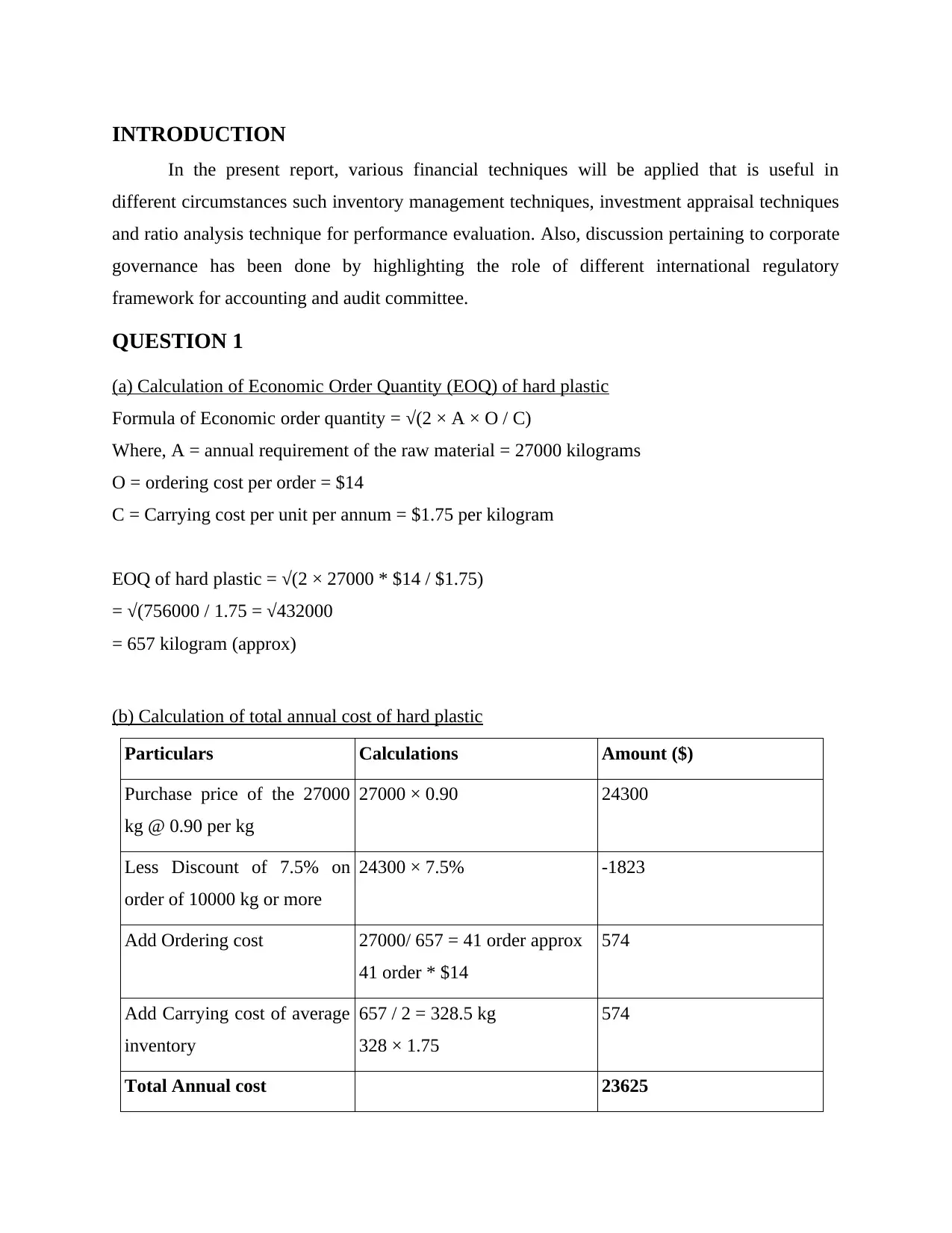
INTRODUCTION
In the present report, various financial techniques will be applied that is useful in
different circumstances such inventory management techniques, investment appraisal techniques
and ratio analysis technique for performance evaluation. Also, discussion pertaining to corporate
governance has been done by highlighting the role of different international regulatory
framework for accounting and audit committee.
QUESTION 1
(a) Calculation of Economic Order Quantity (EOQ) of hard plastic
Formula of Economic order quantity = √(2 × A × O / C)
Where, A = annual requirement of the raw material = 27000 kilograms
O = ordering cost per order = $14
C = Carrying cost per unit per annum = $1.75 per kilogram
EOQ of hard plastic = √(2 × 27000 * $14 / $1.75)
= √(756000 / 1.75 = √432000
= 657 kilogram (approx)
(b) Calculation of total annual cost of hard plastic
Particulars Calculations Amount ($)
Purchase price of the 27000
kg @ 0.90 per kg
27000 × 0.90 24300
Less Discount of 7.5% on
order of 10000 kg or more
24300 × 7.5% -1823
Add Ordering cost 27000/ 657 = 41 order approx
41 order * $14
574
Add Carrying cost of average
inventory
657 / 2 = 328.5 kg
328 × 1.75
574
Total Annual cost 23625
In the present report, various financial techniques will be applied that is useful in
different circumstances such inventory management techniques, investment appraisal techniques
and ratio analysis technique for performance evaluation. Also, discussion pertaining to corporate
governance has been done by highlighting the role of different international regulatory
framework for accounting and audit committee.
QUESTION 1
(a) Calculation of Economic Order Quantity (EOQ) of hard plastic
Formula of Economic order quantity = √(2 × A × O / C)
Where, A = annual requirement of the raw material = 27000 kilograms
O = ordering cost per order = $14
C = Carrying cost per unit per annum = $1.75 per kilogram
EOQ of hard plastic = √(2 × 27000 * $14 / $1.75)
= √(756000 / 1.75 = √432000
= 657 kilogram (approx)
(b) Calculation of total annual cost of hard plastic
Particulars Calculations Amount ($)
Purchase price of the 27000
kg @ 0.90 per kg
27000 × 0.90 24300
Less Discount of 7.5% on
order of 10000 kg or more
24300 × 7.5% -1823
Add Ordering cost 27000/ 657 = 41 order approx
41 order * $14
574
Add Carrying cost of average
inventory
657 / 2 = 328.5 kg
328 × 1.75
574
Total Annual cost 23625
⊘ This is a preview!⊘
Do you want full access?
Subscribe today to unlock all pages.

Trusted by 1+ million students worldwide
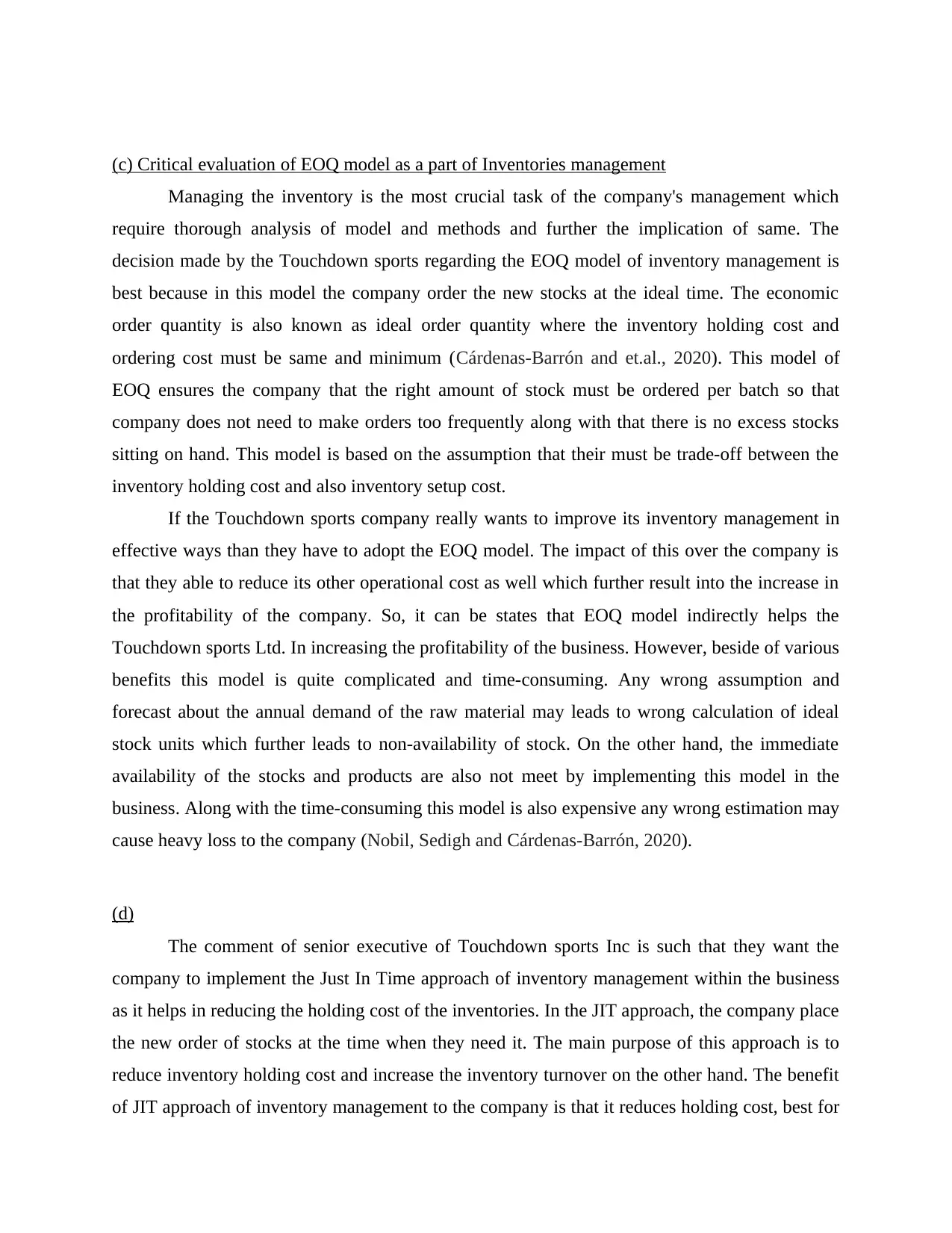
(c) Critical evaluation of EOQ model as a part of Inventories management
Managing the inventory is the most crucial task of the company's management which
require thorough analysis of model and methods and further the implication of same. The
decision made by the Touchdown sports regarding the EOQ model of inventory management is
best because in this model the company order the new stocks at the ideal time. The economic
order quantity is also known as ideal order quantity where the inventory holding cost and
ordering cost must be same and minimum (Cárdenas-Barrón and et.al., 2020). This model of
EOQ ensures the company that the right amount of stock must be ordered per batch so that
company does not need to make orders too frequently along with that there is no excess stocks
sitting on hand. This model is based on the assumption that their must be trade-off between the
inventory holding cost and also inventory setup cost.
If the Touchdown sports company really wants to improve its inventory management in
effective ways than they have to adopt the EOQ model. The impact of this over the company is
that they able to reduce its other operational cost as well which further result into the increase in
the profitability of the company. So, it can be states that EOQ model indirectly helps the
Touchdown sports Ltd. In increasing the profitability of the business. However, beside of various
benefits this model is quite complicated and time-consuming. Any wrong assumption and
forecast about the annual demand of the raw material may leads to wrong calculation of ideal
stock units which further leads to non-availability of stock. On the other hand, the immediate
availability of the stocks and products are also not meet by implementing this model in the
business. Along with the time-consuming this model is also expensive any wrong estimation may
cause heavy loss to the company (Nobil, Sedigh and Cárdenas-Barrón, 2020).
(d)
The comment of senior executive of Touchdown sports Inc is such that they want the
company to implement the Just In Time approach of inventory management within the business
as it helps in reducing the holding cost of the inventories. In the JIT approach, the company place
the new order of stocks at the time when they need it. The main purpose of this approach is to
reduce inventory holding cost and increase the inventory turnover on the other hand. The benefit
of JIT approach of inventory management to the company is that it reduces holding cost, best for
Managing the inventory is the most crucial task of the company's management which
require thorough analysis of model and methods and further the implication of same. The
decision made by the Touchdown sports regarding the EOQ model of inventory management is
best because in this model the company order the new stocks at the ideal time. The economic
order quantity is also known as ideal order quantity where the inventory holding cost and
ordering cost must be same and minimum (Cárdenas-Barrón and et.al., 2020). This model of
EOQ ensures the company that the right amount of stock must be ordered per batch so that
company does not need to make orders too frequently along with that there is no excess stocks
sitting on hand. This model is based on the assumption that their must be trade-off between the
inventory holding cost and also inventory setup cost.
If the Touchdown sports company really wants to improve its inventory management in
effective ways than they have to adopt the EOQ model. The impact of this over the company is
that they able to reduce its other operational cost as well which further result into the increase in
the profitability of the company. So, it can be states that EOQ model indirectly helps the
Touchdown sports Ltd. In increasing the profitability of the business. However, beside of various
benefits this model is quite complicated and time-consuming. Any wrong assumption and
forecast about the annual demand of the raw material may leads to wrong calculation of ideal
stock units which further leads to non-availability of stock. On the other hand, the immediate
availability of the stocks and products are also not meet by implementing this model in the
business. Along with the time-consuming this model is also expensive any wrong estimation may
cause heavy loss to the company (Nobil, Sedigh and Cárdenas-Barrón, 2020).
(d)
The comment of senior executive of Touchdown sports Inc is such that they want the
company to implement the Just In Time approach of inventory management within the business
as it helps in reducing the holding cost of the inventories. In the JIT approach, the company place
the new order of stocks at the time when they need it. The main purpose of this approach is to
reduce inventory holding cost and increase the inventory turnover on the other hand. The benefit
of JIT approach of inventory management to the company is that it reduces holding cost, best for
Paraphrase This Document
Need a fresh take? Get an instant paraphrase of this document with our AI Paraphraser
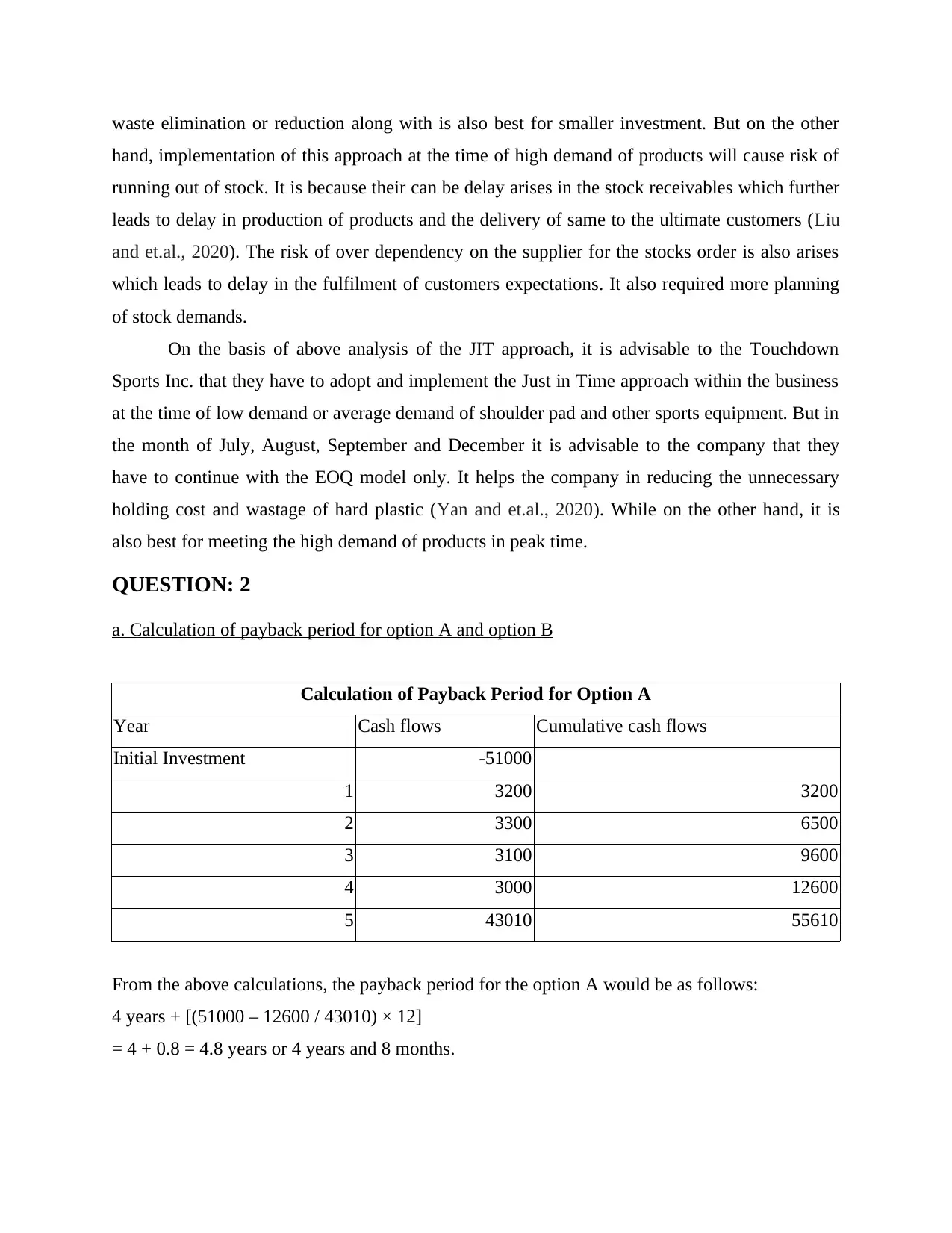
waste elimination or reduction along with is also best for smaller investment. But on the other
hand, implementation of this approach at the time of high demand of products will cause risk of
running out of stock. It is because their can be delay arises in the stock receivables which further
leads to delay in production of products and the delivery of same to the ultimate customers (Liu
and et.al., 2020). The risk of over dependency on the supplier for the stocks order is also arises
which leads to delay in the fulfilment of customers expectations. It also required more planning
of stock demands.
On the basis of above analysis of the JIT approach, it is advisable to the Touchdown
Sports Inc. that they have to adopt and implement the Just in Time approach within the business
at the time of low demand or average demand of shoulder pad and other sports equipment. But in
the month of July, August, September and December it is advisable to the company that they
have to continue with the EOQ model only. It helps the company in reducing the unnecessary
holding cost and wastage of hard plastic (Yan and et.al., 2020). While on the other hand, it is
also best for meeting the high demand of products in peak time.
QUESTION: 2
a. Calculation of payback period for option A and option B
Calculation of Payback Period for Option A
Year Cash flows Cumulative cash flows
Initial Investment -51000
1 3200 3200
2 3300 6500
3 3100 9600
4 3000 12600
5 43010 55610
From the above calculations, the payback period for the option A would be as follows:
4 years + [(51000 – 12600 / 43010) × 12]
= 4 + 0.8 = 4.8 years or 4 years and 8 months.
hand, implementation of this approach at the time of high demand of products will cause risk of
running out of stock. It is because their can be delay arises in the stock receivables which further
leads to delay in production of products and the delivery of same to the ultimate customers (Liu
and et.al., 2020). The risk of over dependency on the supplier for the stocks order is also arises
which leads to delay in the fulfilment of customers expectations. It also required more planning
of stock demands.
On the basis of above analysis of the JIT approach, it is advisable to the Touchdown
Sports Inc. that they have to adopt and implement the Just in Time approach within the business
at the time of low demand or average demand of shoulder pad and other sports equipment. But in
the month of July, August, September and December it is advisable to the company that they
have to continue with the EOQ model only. It helps the company in reducing the unnecessary
holding cost and wastage of hard plastic (Yan and et.al., 2020). While on the other hand, it is
also best for meeting the high demand of products in peak time.
QUESTION: 2
a. Calculation of payback period for option A and option B
Calculation of Payback Period for Option A
Year Cash flows Cumulative cash flows
Initial Investment -51000
1 3200 3200
2 3300 6500
3 3100 9600
4 3000 12600
5 43010 55610
From the above calculations, the payback period for the option A would be as follows:
4 years + [(51000 – 12600 / 43010) × 12]
= 4 + 0.8 = 4.8 years or 4 years and 8 months.
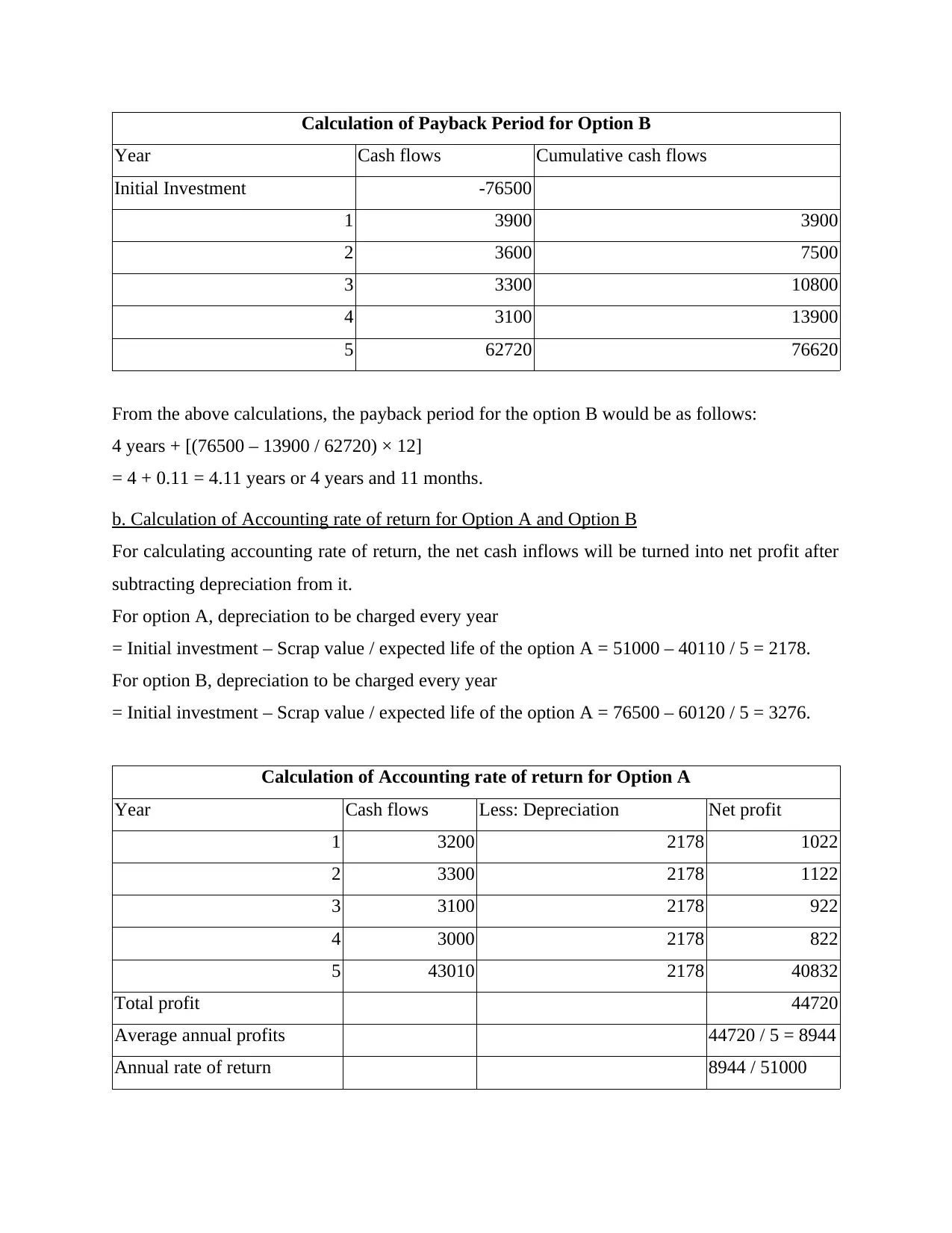
Calculation of Payback Period for Option B
Year Cash flows Cumulative cash flows
Initial Investment -76500
1 3900 3900
2 3600 7500
3 3300 10800
4 3100 13900
5 62720 76620
From the above calculations, the payback period for the option B would be as follows:
4 years + [(76500 – 13900 / 62720) × 12]
= 4 + 0.11 = 4.11 years or 4 years and 11 months.
b. Calculation of Accounting rate of return for Option A and Option B
For calculating accounting rate of return, the net cash inflows will be turned into net profit after
subtracting depreciation from it.
For option A, depreciation to be charged every year
= Initial investment – Scrap value / expected life of the option A = 51000 – 40110 / 5 = 2178.
For option B, depreciation to be charged every year
= Initial investment – Scrap value / expected life of the option A = 76500 – 60120 / 5 = 3276.
Calculation of Accounting rate of return for Option A
Year Cash flows Less: Depreciation Net profit
1 3200 2178 1022
2 3300 2178 1122
3 3100 2178 922
4 3000 2178 822
5 43010 2178 40832
Total profit 44720
Average annual profits 44720 / 5 = 8944
Annual rate of return 8944 / 51000
Year Cash flows Cumulative cash flows
Initial Investment -76500
1 3900 3900
2 3600 7500
3 3300 10800
4 3100 13900
5 62720 76620
From the above calculations, the payback period for the option B would be as follows:
4 years + [(76500 – 13900 / 62720) × 12]
= 4 + 0.11 = 4.11 years or 4 years and 11 months.
b. Calculation of Accounting rate of return for Option A and Option B
For calculating accounting rate of return, the net cash inflows will be turned into net profit after
subtracting depreciation from it.
For option A, depreciation to be charged every year
= Initial investment – Scrap value / expected life of the option A = 51000 – 40110 / 5 = 2178.
For option B, depreciation to be charged every year
= Initial investment – Scrap value / expected life of the option A = 76500 – 60120 / 5 = 3276.
Calculation of Accounting rate of return for Option A
Year Cash flows Less: Depreciation Net profit
1 3200 2178 1022
2 3300 2178 1122
3 3100 2178 922
4 3000 2178 822
5 43010 2178 40832
Total profit 44720
Average annual profits 44720 / 5 = 8944
Annual rate of return 8944 / 51000
⊘ This is a preview!⊘
Do you want full access?
Subscribe today to unlock all pages.

Trusted by 1+ million students worldwide

100 = 17.53%
Calculation of Accounting rate of return for Option B
Year Cash flows Less: Depreciation Net profit
1 3900 3276 624
2 3600 3276 324
3 3300 3276 24
4 3100 3276 -176
5 62720 3276 59444
Total profit 60240
Average annual profits
60240 / 5 =
12048
Annual rate of return
12048 / 76500 *
100 = 15.75%
Calculation of Accounting rate of return for Option B
Year Cash flows Less: Depreciation Net profit
1 3900 3276 624
2 3600 3276 324
3 3300 3276 24
4 3100 3276 -176
5 62720 3276 59444
Total profit 60240
Average annual profits
60240 / 5 =
12048
Annual rate of return
12048 / 76500 *
100 = 15.75%
Paraphrase This Document
Need a fresh take? Get an instant paraphrase of this document with our AI Paraphraser
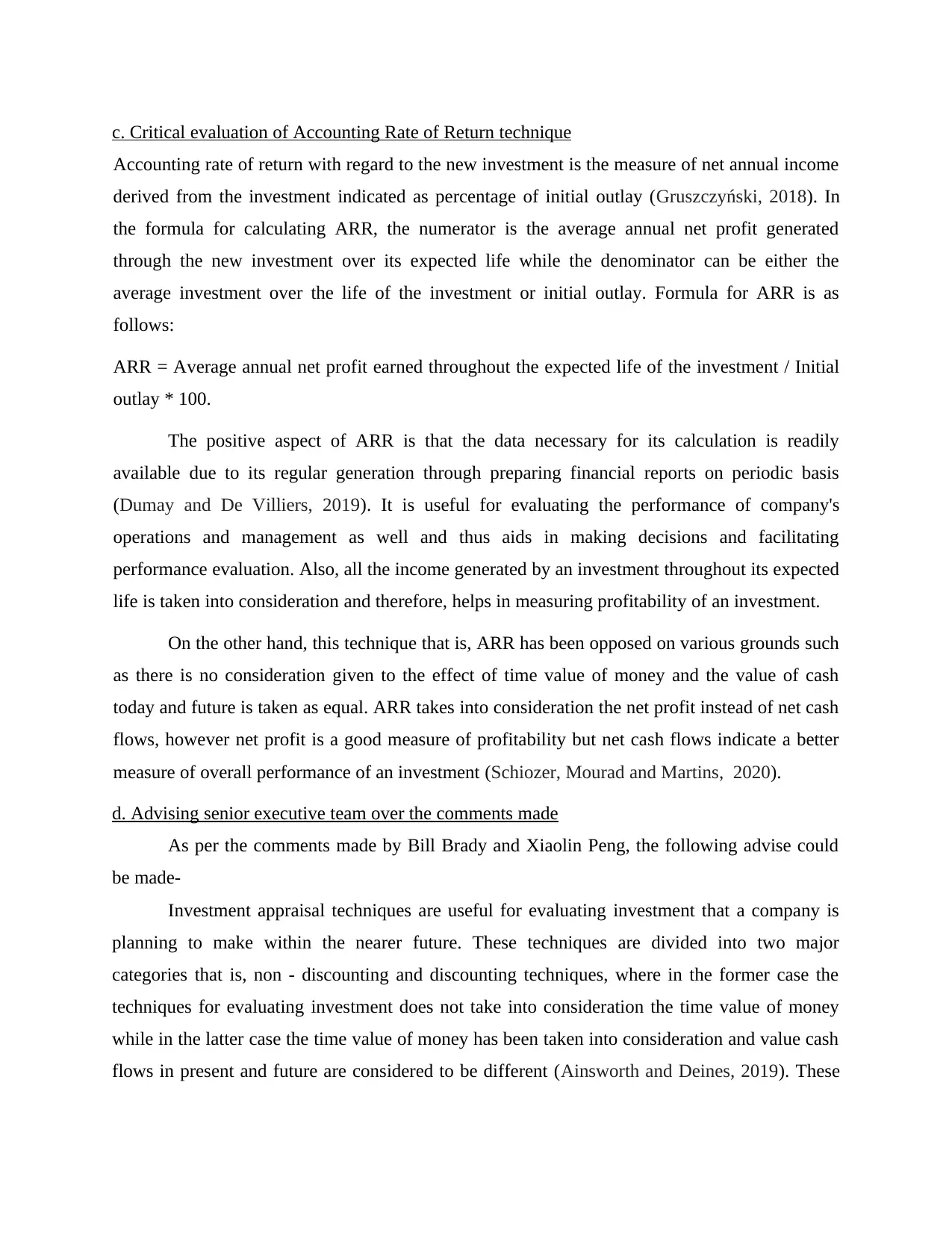
c. Critical evaluation of Accounting Rate of Return technique
Accounting rate of return with regard to the new investment is the measure of net annual income
derived from the investment indicated as percentage of initial outlay (Gruszczyński, 2018). In
the formula for calculating ARR, the numerator is the average annual net profit generated
through the new investment over its expected life while the denominator can be either the
average investment over the life of the investment or initial outlay. Formula for ARR is as
follows:
ARR = Average annual net profit earned throughout the expected life of the investment / Initial
outlay * 100.
The positive aspect of ARR is that the data necessary for its calculation is readily
available due to its regular generation through preparing financial reports on periodic basis
(Dumay and De Villiers, 2019). It is useful for evaluating the performance of company's
operations and management as well and thus aids in making decisions and facilitating
performance evaluation. Also, all the income generated by an investment throughout its expected
life is taken into consideration and therefore, helps in measuring profitability of an investment.
On the other hand, this technique that is, ARR has been opposed on various grounds such
as there is no consideration given to the effect of time value of money and the value of cash
today and future is taken as equal. ARR takes into consideration the net profit instead of net cash
flows, however net profit is a good measure of profitability but net cash flows indicate a better
measure of overall performance of an investment (Schiozer, Mourad and Martins, 2020).
d. Advising senior executive team over the comments made
As per the comments made by Bill Brady and Xiaolin Peng, the following advise could
be made-
Investment appraisal techniques are useful for evaluating investment that a company is
planning to make within the nearer future. These techniques are divided into two major
categories that is, non - discounting and discounting techniques, where in the former case the
techniques for evaluating investment does not take into consideration the time value of money
while in the latter case the time value of money has been taken into consideration and value cash
flows in present and future are considered to be different (Ainsworth and Deines, 2019). These
Accounting rate of return with regard to the new investment is the measure of net annual income
derived from the investment indicated as percentage of initial outlay (Gruszczyński, 2018). In
the formula for calculating ARR, the numerator is the average annual net profit generated
through the new investment over its expected life while the denominator can be either the
average investment over the life of the investment or initial outlay. Formula for ARR is as
follows:
ARR = Average annual net profit earned throughout the expected life of the investment / Initial
outlay * 100.
The positive aspect of ARR is that the data necessary for its calculation is readily
available due to its regular generation through preparing financial reports on periodic basis
(Dumay and De Villiers, 2019). It is useful for evaluating the performance of company's
operations and management as well and thus aids in making decisions and facilitating
performance evaluation. Also, all the income generated by an investment throughout its expected
life is taken into consideration and therefore, helps in measuring profitability of an investment.
On the other hand, this technique that is, ARR has been opposed on various grounds such
as there is no consideration given to the effect of time value of money and the value of cash
today and future is taken as equal. ARR takes into consideration the net profit instead of net cash
flows, however net profit is a good measure of profitability but net cash flows indicate a better
measure of overall performance of an investment (Schiozer, Mourad and Martins, 2020).
d. Advising senior executive team over the comments made
As per the comments made by Bill Brady and Xiaolin Peng, the following advise could
be made-
Investment appraisal techniques are useful for evaluating investment that a company is
planning to make within the nearer future. These techniques are divided into two major
categories that is, non - discounting and discounting techniques, where in the former case the
techniques for evaluating investment does not take into consideration the time value of money
while in the latter case the time value of money has been taken into consideration and value cash
flows in present and future are considered to be different (Ainsworth and Deines, 2019). These
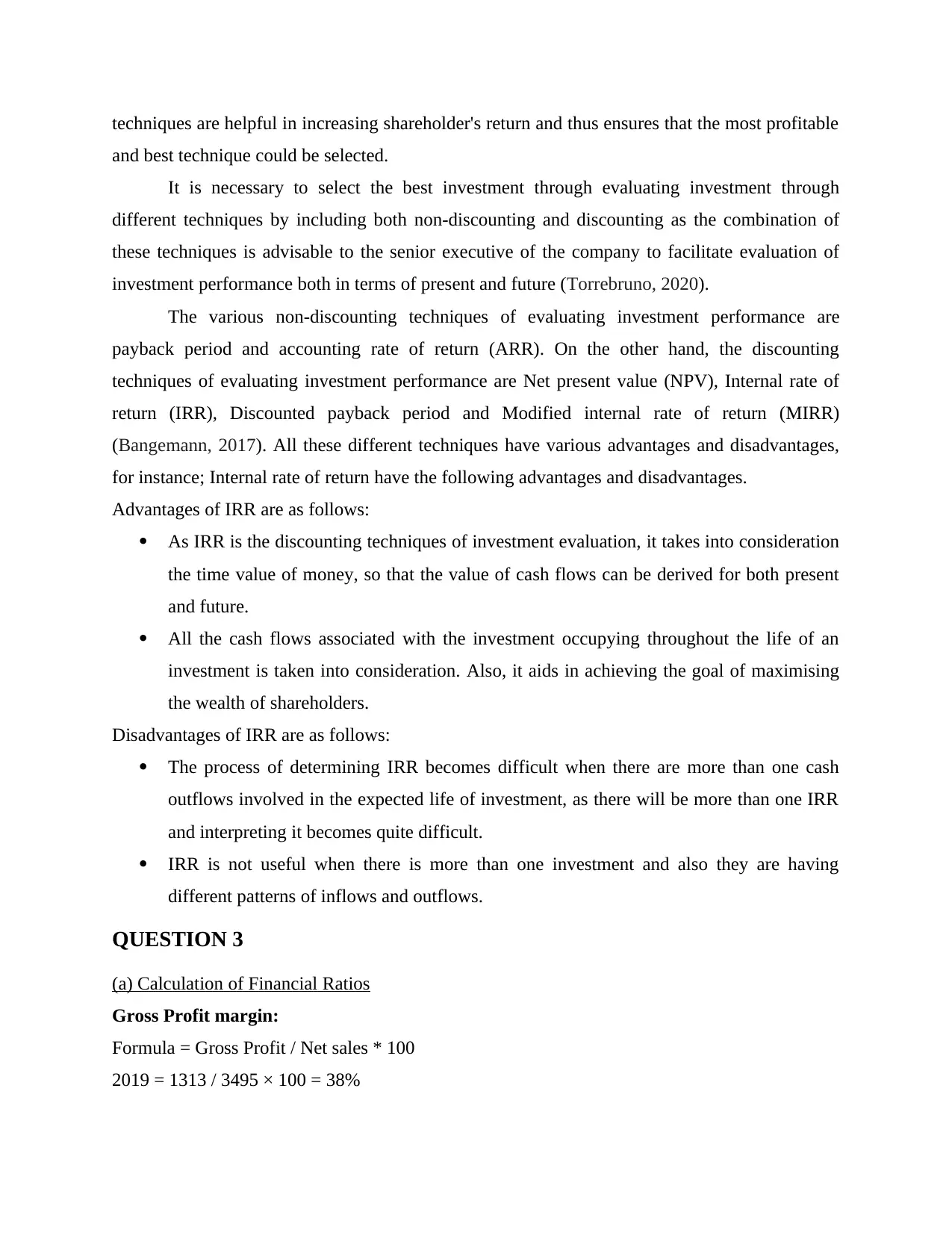
techniques are helpful in increasing shareholder's return and thus ensures that the most profitable
and best technique could be selected.
It is necessary to select the best investment through evaluating investment through
different techniques by including both non-discounting and discounting as the combination of
these techniques is advisable to the senior executive of the company to facilitate evaluation of
investment performance both in terms of present and future (Torrebruno, 2020).
The various non-discounting techniques of evaluating investment performance are
payback period and accounting rate of return (ARR). On the other hand, the discounting
techniques of evaluating investment performance are Net present value (NPV), Internal rate of
return (IRR), Discounted payback period and Modified internal rate of return (MIRR)
(Bangemann, 2017). All these different techniques have various advantages and disadvantages,
for instance; Internal rate of return have the following advantages and disadvantages.
Advantages of IRR are as follows:
As IRR is the discounting techniques of investment evaluation, it takes into consideration
the time value of money, so that the value of cash flows can be derived for both present
and future.
All the cash flows associated with the investment occupying throughout the life of an
investment is taken into consideration. Also, it aids in achieving the goal of maximising
the wealth of shareholders.
Disadvantages of IRR are as follows:
The process of determining IRR becomes difficult when there are more than one cash
outflows involved in the expected life of investment, as there will be more than one IRR
and interpreting it becomes quite difficult.
IRR is not useful when there is more than one investment and also they are having
different patterns of inflows and outflows.
QUESTION 3
(a) Calculation of Financial Ratios
Gross Profit margin:
Formula = Gross Profit / Net sales * 100
2019 = 1313 / 3495 × 100 = 38%
and best technique could be selected.
It is necessary to select the best investment through evaluating investment through
different techniques by including both non-discounting and discounting as the combination of
these techniques is advisable to the senior executive of the company to facilitate evaluation of
investment performance both in terms of present and future (Torrebruno, 2020).
The various non-discounting techniques of evaluating investment performance are
payback period and accounting rate of return (ARR). On the other hand, the discounting
techniques of evaluating investment performance are Net present value (NPV), Internal rate of
return (IRR), Discounted payback period and Modified internal rate of return (MIRR)
(Bangemann, 2017). All these different techniques have various advantages and disadvantages,
for instance; Internal rate of return have the following advantages and disadvantages.
Advantages of IRR are as follows:
As IRR is the discounting techniques of investment evaluation, it takes into consideration
the time value of money, so that the value of cash flows can be derived for both present
and future.
All the cash flows associated with the investment occupying throughout the life of an
investment is taken into consideration. Also, it aids in achieving the goal of maximising
the wealth of shareholders.
Disadvantages of IRR are as follows:
The process of determining IRR becomes difficult when there are more than one cash
outflows involved in the expected life of investment, as there will be more than one IRR
and interpreting it becomes quite difficult.
IRR is not useful when there is more than one investment and also they are having
different patterns of inflows and outflows.
QUESTION 3
(a) Calculation of Financial Ratios
Gross Profit margin:
Formula = Gross Profit / Net sales * 100
2019 = 1313 / 3495 × 100 = 38%
⊘ This is a preview!⊘
Do you want full access?
Subscribe today to unlock all pages.

Trusted by 1+ million students worldwide

Assets Usage ratio:
Formula = Net Sales / Total Assets
2019 = 3495 / 3812 = 0.92
Current Ratio:
Formula = Current Assets / Current Liabilities
Current assets = Inventory + Trade receivable + Short term investment + Cash at bank
Current liabilities = Trade payables + Bank overdraft + Taxation
2018 = (102 + 315 + 0 + 1) / (119 + 98 + 285)
= 418 / 502 = 0.83
2019 = (150 + 1010 + 75 + 452) / (289 + 143 + 312)
= 1687 / 744 = 2.27
Acid Test Ratio:
Formula = (Current assets – Inventory) / Current Liabilities
2018 = (418 – 102) / 502
= 316 / 502 = 0.63
2019 = (1687 – 150) / 744
= 1537/ 744 = 2.07
Inventories holding period:
Formula = (Inventory / Cost of goods sold) * 365 days
2019 = 150 / 2182 × 365 days = 25 days approx.
Debt to Equity Ratio:
Formula = Total Debt/ Total Equity
Total Debt = Current liabilities + non-current liabilities
2018 = 502 + 50 = 552
2019 = 744 + 170 = 914
Total equity = share capital + share premium account + revaluation surplus + retained earnings
Formula = Net Sales / Total Assets
2019 = 3495 / 3812 = 0.92
Current Ratio:
Formula = Current Assets / Current Liabilities
Current assets = Inventory + Trade receivable + Short term investment + Cash at bank
Current liabilities = Trade payables + Bank overdraft + Taxation
2018 = (102 + 315 + 0 + 1) / (119 + 98 + 285)
= 418 / 502 = 0.83
2019 = (150 + 1010 + 75 + 452) / (289 + 143 + 312)
= 1687 / 744 = 2.27
Acid Test Ratio:
Formula = (Current assets – Inventory) / Current Liabilities
2018 = (418 – 102) / 502
= 316 / 502 = 0.63
2019 = (1687 – 150) / 744
= 1537/ 744 = 2.07
Inventories holding period:
Formula = (Inventory / Cost of goods sold) * 365 days
2019 = 150 / 2182 × 365 days = 25 days approx.
Debt to Equity Ratio:
Formula = Total Debt/ Total Equity
Total Debt = Current liabilities + non-current liabilities
2018 = 502 + 50 = 552
2019 = 744 + 170 = 914
Total equity = share capital + share premium account + revaluation surplus + retained earnings
Paraphrase This Document
Need a fresh take? Get an instant paraphrase of this document with our AI Paraphraser
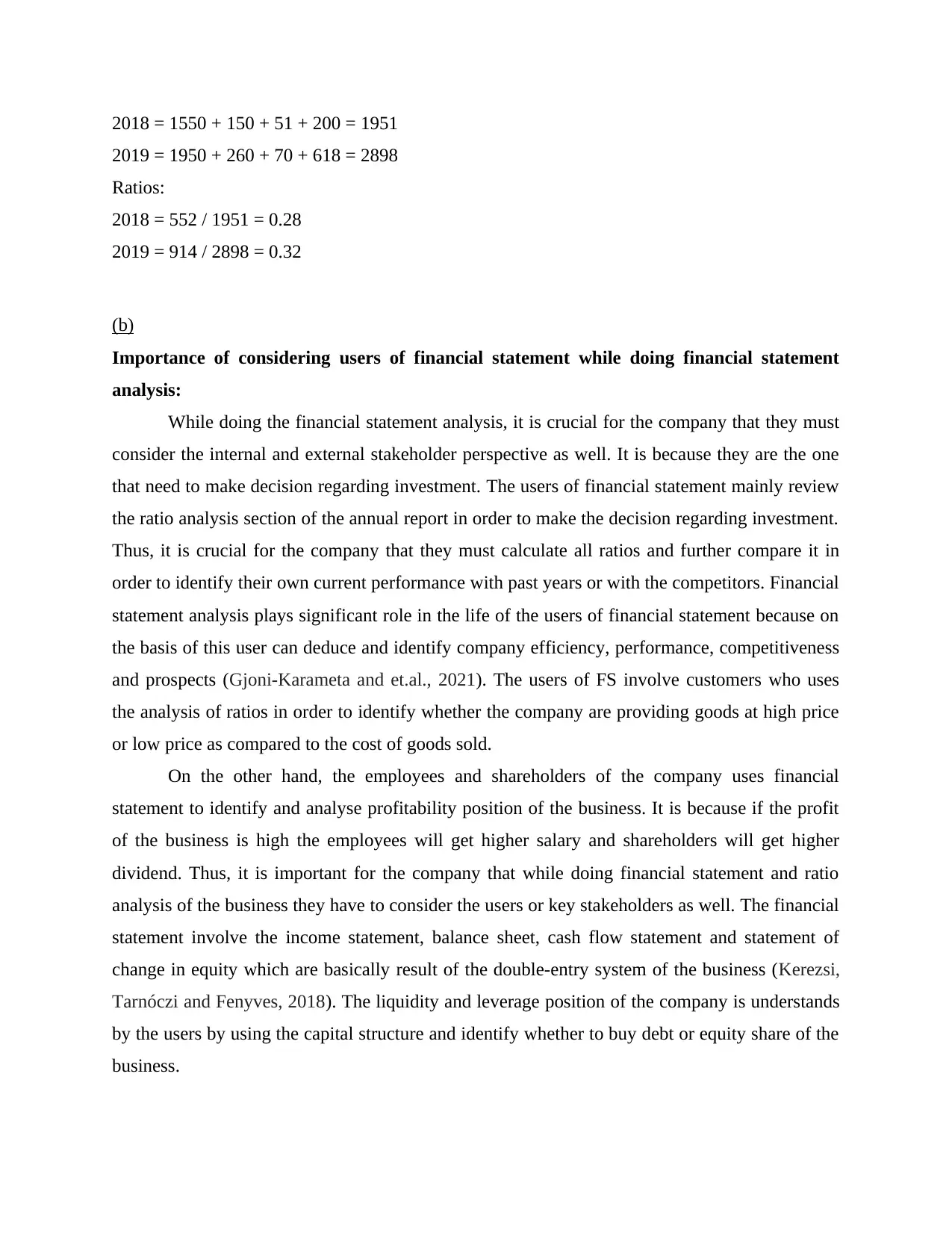
2018 = 1550 + 150 + 51 + 200 = 1951
2019 = 1950 + 260 + 70 + 618 = 2898
Ratios:
2018 = 552 / 1951 = 0.28
2019 = 914 / 2898 = 0.32
(b)
Importance of considering users of financial statement while doing financial statement
analysis:
While doing the financial statement analysis, it is crucial for the company that they must
consider the internal and external stakeholder perspective as well. It is because they are the one
that need to make decision regarding investment. The users of financial statement mainly review
the ratio analysis section of the annual report in order to make the decision regarding investment.
Thus, it is crucial for the company that they must calculate all ratios and further compare it in
order to identify their own current performance with past years or with the competitors. Financial
statement analysis plays significant role in the life of the users of financial statement because on
the basis of this user can deduce and identify company efficiency, performance, competitiveness
and prospects (Gjoni-Karameta and et.al., 2021). The users of FS involve customers who uses
the analysis of ratios in order to identify whether the company are providing goods at high price
or low price as compared to the cost of goods sold.
On the other hand, the employees and shareholders of the company uses financial
statement to identify and analyse profitability position of the business. It is because if the profit
of the business is high the employees will get higher salary and shareholders will get higher
dividend. Thus, it is important for the company that while doing financial statement and ratio
analysis of the business they have to consider the users or key stakeholders as well. The financial
statement involve the income statement, balance sheet, cash flow statement and statement of
change in equity which are basically result of the double-entry system of the business (Kerezsi,
Tarnóczi and Fenyves, 2018). The liquidity and leverage position of the company is understands
by the users by using the capital structure and identify whether to buy debt or equity share of the
business.
2019 = 1950 + 260 + 70 + 618 = 2898
Ratios:
2018 = 552 / 1951 = 0.28
2019 = 914 / 2898 = 0.32
(b)
Importance of considering users of financial statement while doing financial statement
analysis:
While doing the financial statement analysis, it is crucial for the company that they must
consider the internal and external stakeholder perspective as well. It is because they are the one
that need to make decision regarding investment. The users of financial statement mainly review
the ratio analysis section of the annual report in order to make the decision regarding investment.
Thus, it is crucial for the company that they must calculate all ratios and further compare it in
order to identify their own current performance with past years or with the competitors. Financial
statement analysis plays significant role in the life of the users of financial statement because on
the basis of this user can deduce and identify company efficiency, performance, competitiveness
and prospects (Gjoni-Karameta and et.al., 2021). The users of FS involve customers who uses
the analysis of ratios in order to identify whether the company are providing goods at high price
or low price as compared to the cost of goods sold.
On the other hand, the employees and shareholders of the company uses financial
statement to identify and analyse profitability position of the business. It is because if the profit
of the business is high the employees will get higher salary and shareholders will get higher
dividend. Thus, it is important for the company that while doing financial statement and ratio
analysis of the business they have to consider the users or key stakeholders as well. The financial
statement involve the income statement, balance sheet, cash flow statement and statement of
change in equity which are basically result of the double-entry system of the business (Kerezsi,
Tarnóczi and Fenyves, 2018). The liquidity and leverage position of the company is understands
by the users by using the capital structure and identify whether to buy debt or equity share of the
business.
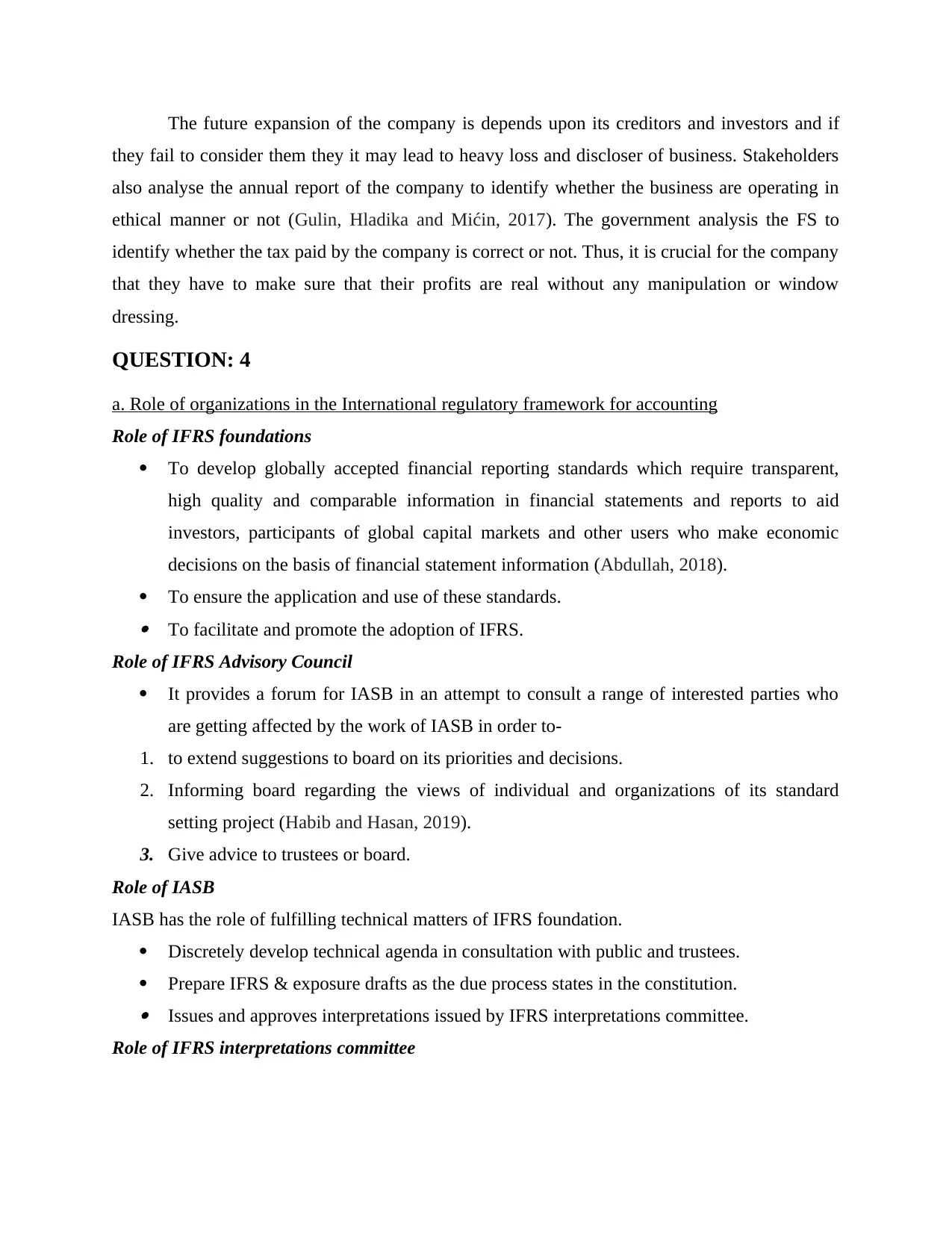
The future expansion of the company is depends upon its creditors and investors and if
they fail to consider them they it may lead to heavy loss and discloser of business. Stakeholders
also analyse the annual report of the company to identify whether the business are operating in
ethical manner or not (Gulin, Hladika and Mićin, 2017). The government analysis the FS to
identify whether the tax paid by the company is correct or not. Thus, it is crucial for the company
that they have to make sure that their profits are real without any manipulation or window
dressing.
QUESTION: 4
a. Role of organizations in the International regulatory framework for accounting
Role of IFRS foundations
To develop globally accepted financial reporting standards which require transparent,
high quality and comparable information in financial statements and reports to aid
investors, participants of global capital markets and other users who make economic
decisions on the basis of financial statement information (Abdullah, 2018).
To ensure the application and use of these standards. To facilitate and promote the adoption of IFRS.
Role of IFRS Advisory Council
It provides a forum for IASB in an attempt to consult a range of interested parties who
are getting affected by the work of IASB in order to-
1. to extend suggestions to board on its priorities and decisions.
2. Informing board regarding the views of individual and organizations of its standard
setting project (Habib and Hasan, 2019).
3. Give advice to trustees or board.
Role of IASB
IASB has the role of fulfilling technical matters of IFRS foundation.
Discretely develop technical agenda in consultation with public and trustees.
Prepare IFRS & exposure drafts as the due process states in the constitution. Issues and approves interpretations issued by IFRS interpretations committee.
Role of IFRS interpretations committee
they fail to consider them they it may lead to heavy loss and discloser of business. Stakeholders
also analyse the annual report of the company to identify whether the business are operating in
ethical manner or not (Gulin, Hladika and Mićin, 2017). The government analysis the FS to
identify whether the tax paid by the company is correct or not. Thus, it is crucial for the company
that they have to make sure that their profits are real without any manipulation or window
dressing.
QUESTION: 4
a. Role of organizations in the International regulatory framework for accounting
Role of IFRS foundations
To develop globally accepted financial reporting standards which require transparent,
high quality and comparable information in financial statements and reports to aid
investors, participants of global capital markets and other users who make economic
decisions on the basis of financial statement information (Abdullah, 2018).
To ensure the application and use of these standards. To facilitate and promote the adoption of IFRS.
Role of IFRS Advisory Council
It provides a forum for IASB in an attempt to consult a range of interested parties who
are getting affected by the work of IASB in order to-
1. to extend suggestions to board on its priorities and decisions.
2. Informing board regarding the views of individual and organizations of its standard
setting project (Habib and Hasan, 2019).
3. Give advice to trustees or board.
Role of IASB
IASB has the role of fulfilling technical matters of IFRS foundation.
Discretely develop technical agenda in consultation with public and trustees.
Prepare IFRS & exposure drafts as the due process states in the constitution. Issues and approves interpretations issued by IFRS interpretations committee.
Role of IFRS interpretations committee
⊘ This is a preview!⊘
Do you want full access?
Subscribe today to unlock all pages.

Trusted by 1+ million students worldwide
1 out of 15
Related Documents
Your All-in-One AI-Powered Toolkit for Academic Success.
+13062052269
info@desklib.com
Available 24*7 on WhatsApp / Email
![[object Object]](/_next/static/media/star-bottom.7253800d.svg)
Unlock your academic potential
Copyright © 2020–2025 A2Z Services. All Rights Reserved. Developed and managed by ZUCOL.





